Several different types of inscribed stone monument of the North Italian Iron Age are interpreted as funerary markers and so could be described as ‘tombstones’. In the traditional classification of these monuments, the primary criterion used is the language of the inscription — Etruscan or Venetic — and the monuments assigned to the two different language groups are almost never discussed together. In this traditional scholarship, language boundaries are considered to constitute very hard edges and to correlate precisely with distinctions between archaeological cultures. A second criterion is the typology of the monuments, variously described as stelae, cippi or ciottoloni.1 What is never included in the classification process, and is rarely discussed in any detail, is the arrangement of the writing on the surface of the stone and its relationship to the iconography, where present.
This chapter examines the tombstones from a different perspective, that places the form and arrangement of the writing (rather than the language or content of the inscription) at the centre of the analysis. However, I shall begin by providing a brief description of the monuments, in order to make it easier to relate my discussion to the published literature (though, while I shall cite the most important works on the various monuments, I shall make no attempt to present a comprehensive bibliography, which is unnecessary in the present context). The map (Figure 1) shows the location of the sites mentioned in the text.
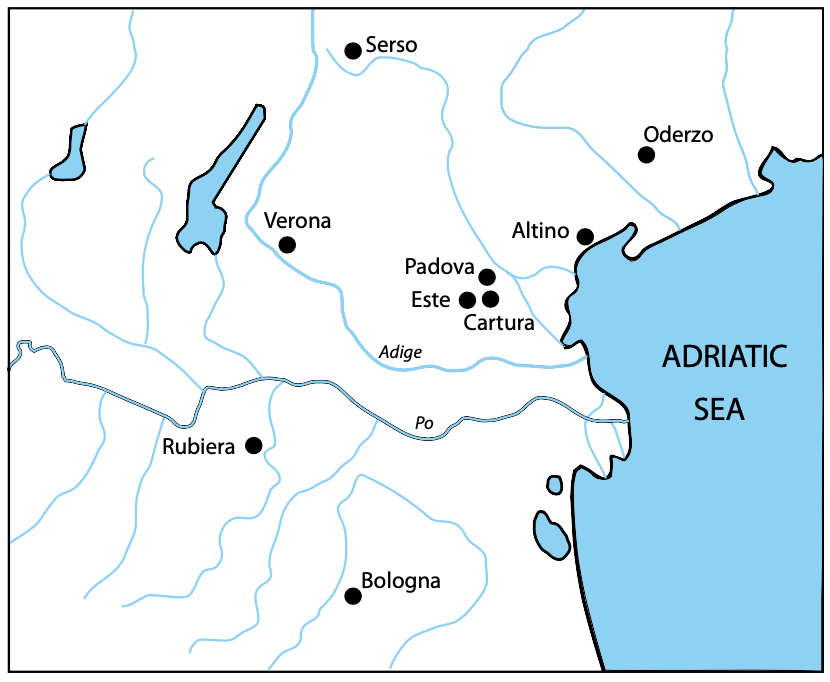
Figure 1: Map of northeast Italy showing location of main sites mentioned in the text.
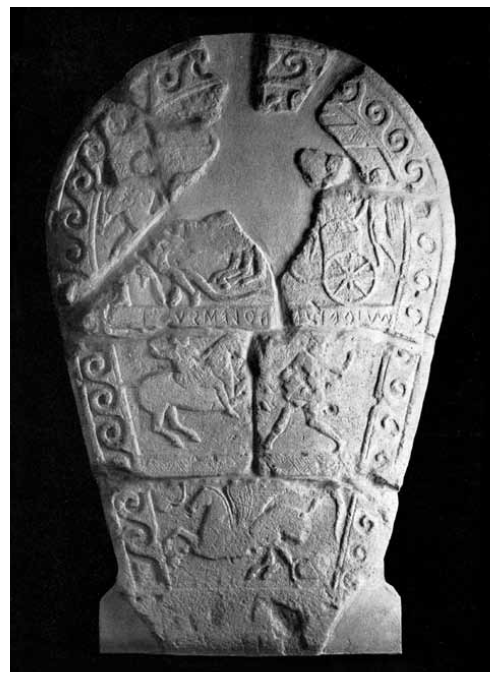
Figure 2: Bologna stele 42. Sandstone. Height: 191 cm. The incised inscription, in Etruscan, reads from right to left. It is transliterated as mi vetus [k[athles suthi and translated as ‘I am the grave of Vetu Kathle’. Bologna, Museo Civico Archeologico, inv. no. Ducati 42. © Bologna, Museo Civico Bologna.
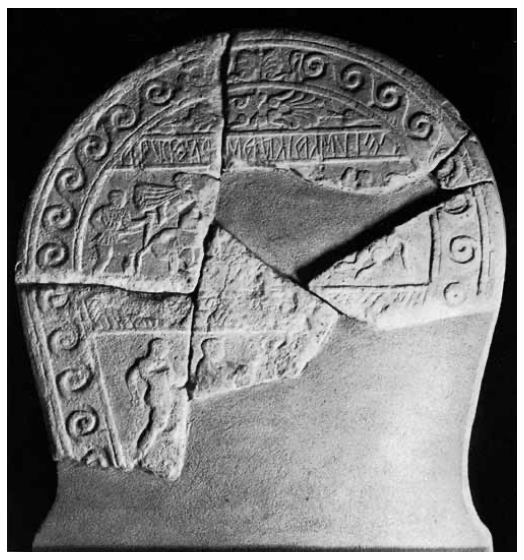
Figure 3: Bologna stele 15. Sandstone. Height: 100 cm. The incised inscription, in Etruscan, reads from right to left. It is transliterated as velus kaiknas arnthrusla and translated as ‘(grave) of Vel Kaikna (son) of Arnthur’. Bologna, Museo Civico Archeologico: inv. no. Ducati 15. © Bologna, Museo Civico Bologna.
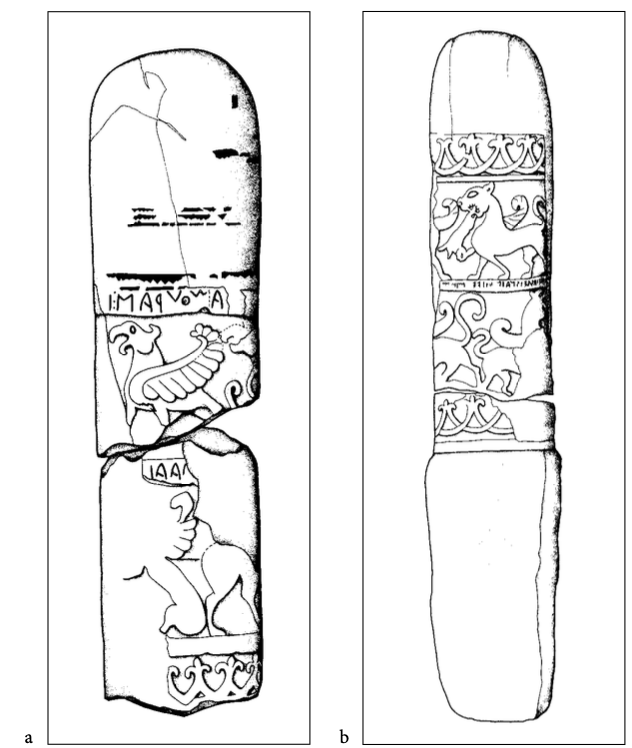
Figure 4: Rubiera stelae, Et Pa 1.1 and Et Pa 1.2. a) Sandstone. Height: 141 cm. The incised inscription, in Etruscan, reads from right to left and runs round the circumference of the stone. It is transliterated as mi aviles amthuras ima ame [---]eius lqr b) [---]ma al[---] and translated as ‘I am of Avle Amthura ????’; b) Sandstone. Height: 177 cm. The incised inscription, in Etruscan, reads from right to left and runs round the circumference of the stone. It is transliterated as kuvei puleisnai mi isive [---] mise [---] mulvlenke zilath mi salalati amake; the translation is disputed but seems to involve two people, one female (Kuvei Puleisnai) and a second, assumed to be male, who was zilath at a place called either Misala or Sala. Reggio Emilia, Musei Civici (after De Simone 1992: Tav. 1).
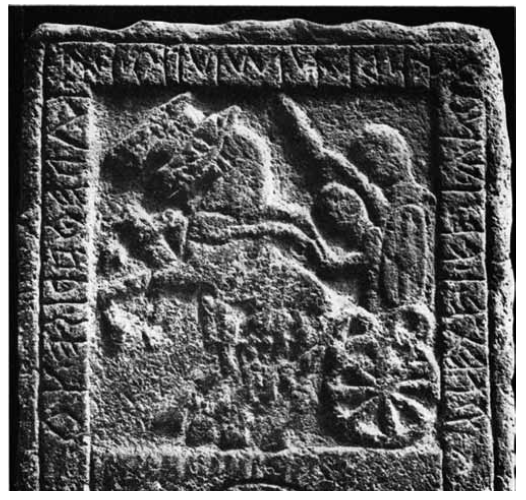
Figure 5: Padua stele, Pa2. Trachyte. Height: 86 cm. The incised inscription, in Venetic, reads from right to left, starting in the bottom right corner and running round three sides of the relief carved figured panel. It is transliterated as mi aletei veignoi karamniioi ekupetaris ego and translated as ‘I am to Aletes Veignos Karamniios the ekupetaris’ or ‘I am the ekupetaris to Aletes Veignos Karamniios’. Verona, Museo Lapidario Maffeiano: inv. 28741.
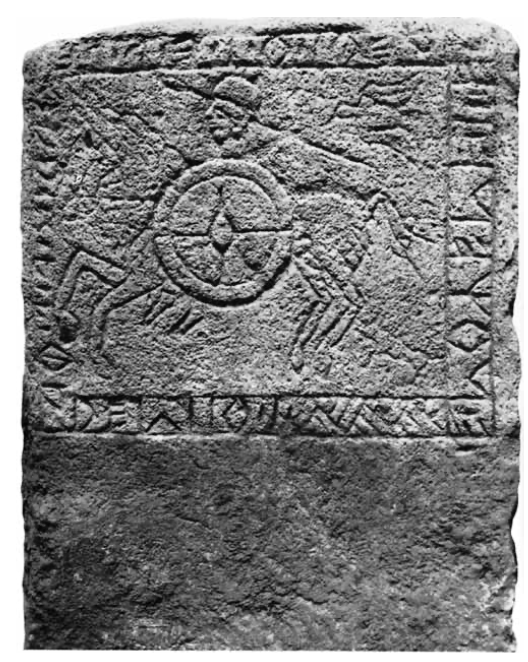
Figure 6: Padua stele, Pa3bis. Trachyte. Height: 90 cm. The incised inscription, in Venetic, reads from right to left, starting in the bottom right corner and running round four sides of the incised figured panel. It is transliterated as enogenei enetiioi eppetaris albarenioi and translated as ‘to Enogenes Enetios Albarenios the ekupetaris’ or ‘(I am) the ekupetaris to Enogenes Enetios Albarenios’. Padova, Museo Civico. © Assessorato alla Cultura, Comune di Padova.
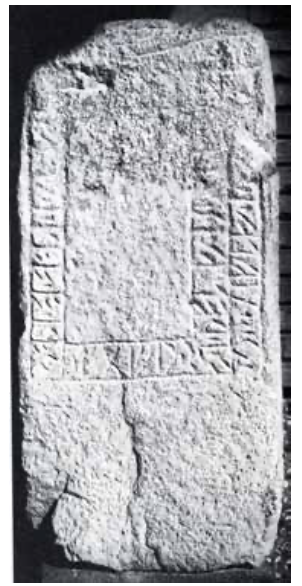
Figure 7: Altino stele, Tr7. Trachyte. Height: 115 cm. The incised inscription, in Venetic, reads from right to left; although the top part is badly damaged it is possible to see that it origi- nally had 6 lines, starting in the bottom right corner and arranged in a spiral pattern, with line 5 inside line 1 and line 6 inside line 2. It is transliterated as ostialai A[---- | ----| ---]nai- kve ekvopetars | fremaist[---- | ----ia]bos and translated as ‘to Ostiala a[-------] and [-------] na Freimast[-----] the ekupetaris’ or ‘Funerary monument to Ostiala a[-------] and for [------] na, Fremaist[----]’. Altino, Museo Archeologico Nazionale: inv. AL 11732. Published with the permission of Ministero dei beni e delle attività culturali e del turismo; reproduction prohibited.
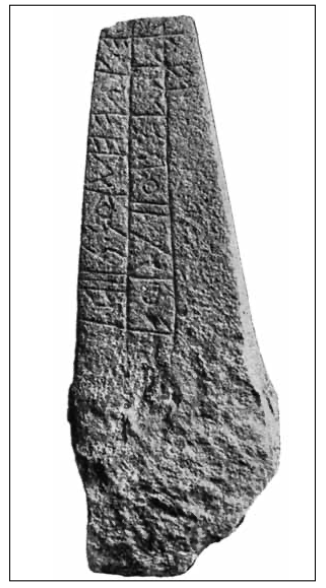
Figure 8: Este stele, Es2. Trachyte. Height: 64.5 cm. The incised inscription, in Venetic, reads from right to left, starting in the top left corner and running first down, then up, then down again. It is transliterated as ego fukssiai voltiommninai and translated as ‘I am (the tomb) to Fukssia Voltiomnina’. Este, Museo Nazionale di Atestino. Published with the permission of Ministero dei beni e delle attività culturali e del turismo; reproduction prohibited.
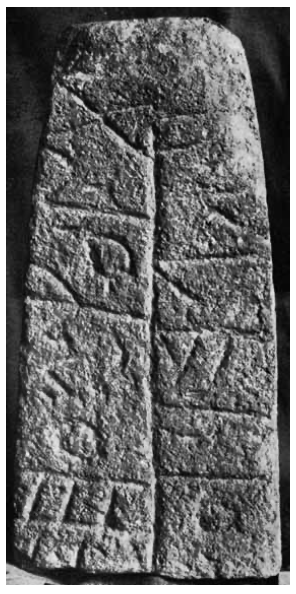
Figure 9: Este stele, Es13. Trachyte. Height: 29 cm. The incised inscription, in Venetic, reads from left to right, starting in the bottom left corner and running first up, then down. It is transliterated as fougonte[i urk]leoi (ego may be missing) and translated as ‘(I am the tomb) to Fugontes Urkleos’. Este, Museo Nazionale di Atestino. Published with the permission of Ministero dei beni e delle attività culturali e del turismo; reproduction prohibited.
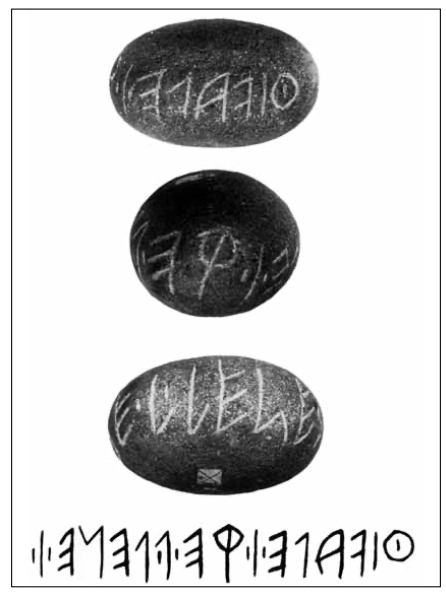
Figure 10: Padua ciottolone Pa25. Porphyry. Dimensions: 23 × 17 × 14 cm. Photographs taken from different sides of ciottolone with transcription of complete inscription. The incised inscription, in Venetic, reads from right to left and runs round the circumference of the stone. It is transliterated as tivalei bellenei and translated as ‘to Tivales Bellenios’. Museo di Scienze Archeologiche e d’Arte dell’Università di Padova. Published with the permission of Ministero dei beni e delle attività culturali e del turismo; reproduction prohibited.
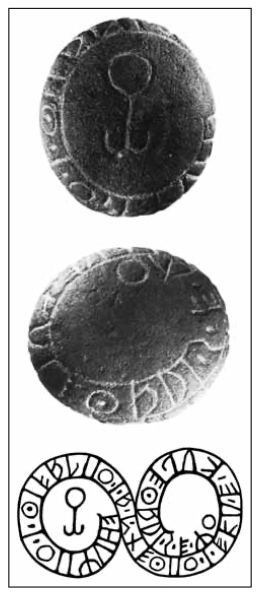
Figure 11: Padua ciottolone Pa26. Porphyry. Dimensions: 25.7 × 23 × 17 cm. Photographs taken from different sides of the ciottolone and transcription of complete inscription. The incised inscription, in Venetic, reads from left to right and runs round the circumference of the stone in a figure-of-eight configuration. It is transliterated as fugioi tivalioi andetioi ekupetaris ego and translated as ‘I am to Fugios Tivalios Andetios the ekupetraris’ or ‘I am the monument to Fugios Tivalios Andetios’. Este, Museo Nazionale di Atestine: inv. IG 145813. Published with the permission of Ministero dei beni e delle attività culturali e del turismo; reproduction prohibited.

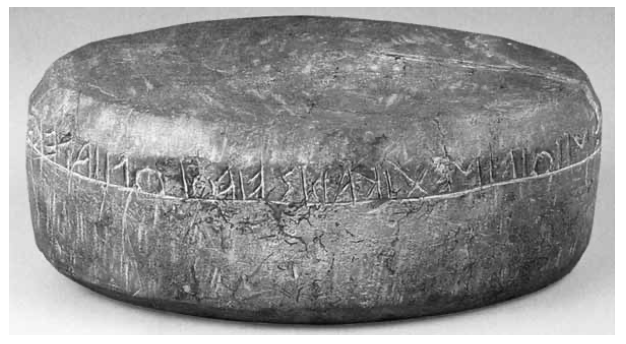
Figure 12: The Cartura stone Es122. Limestone. Dimensions: 27 × 17 × 10 cm. The incised inscription, in Venetic, reads from right to left and runs round the circumference of the stone. It is transliterated as ego fontei ersiniioi vinetikaris vivoi oliialekve murtuvioi atisteit and translated as ‘I am to Fontis Ersinios; the vinetikaris set this up (to him) whether living or dead’. Este, Museo Nazionale Atestino: inv. IG 41528. Published with the permission of Ministero dei beni e delle attività culturali e del turismo; reproduction prohibited.
1 The terms stele (Greek; the Italian version is either stela or stele) and cippus (Latin; the Italian version is cippo) are both used to describe standing stones. I have been unable to find definitions that separate them consistently, although there is a tendency to use stele for rectangular stones with flat faces and cippus for other shapes, such as cylinders or obelisk shapes. In this chapter I use the terms traditionally employed for the particular monuments in question. The Italian term ciottolone means literally ‘big pebble’, which is an accurate description of this type of monument.














